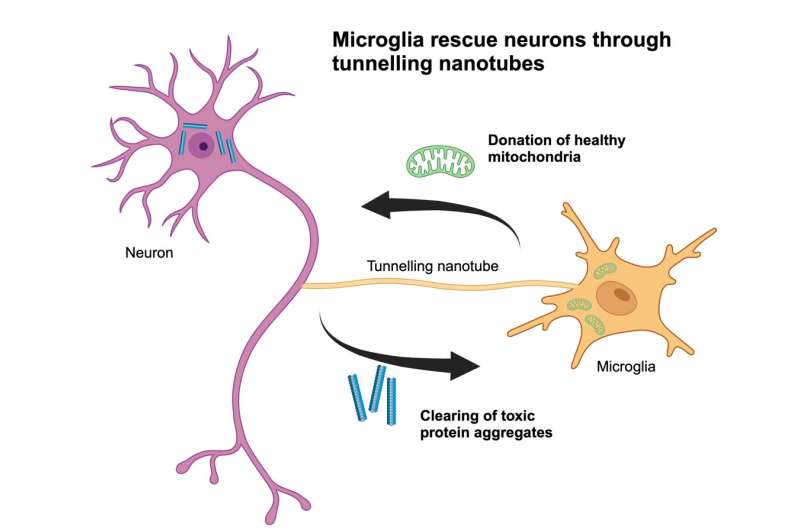This article has been reviewed according to Science X's editorial process and policies. Editors have highlighted the following attributes while ensuring the content's credibility:
fact-checked
peer-reviewed publication
trusted source
proofread
Building bridges between cells for brain health: Research finds microglia rescue neurons through tunneling nanotubes

The brain contains many cell types, from the prominent neurons to the lesser-known microglia. The latter are integral to the brain's immune system and play a crucial role as the brain's cleanup crew. A recent study conducted by researchers from the University Hospital Bonn and the Luxembourg Centre for Systems Biomedicine (LCSB) at the University of Luxembourg, in collaboration with colleagues from France, Hungary, and Germany, highlights that microglia establish connections with neurons through tunneling nanotubes.
The researchers observed that microglia utilize these tubes to facilitate the clearance of toxic proteins from neurons and to promote neuronal health. These findings, published in the journal Neuron, suggest that this mechanism has a pivotal role in mitigating the progression of neurodegenerative diseases.
The accumulation of pathological proteins is a hallmark of several neurodegenerative disorders, including Alzheimer's disease, frontotemporal dementia and Parkinson's disease. Proteins such as alpha-synuclein and tau can abnormally aggregate inside neurons, disrupting essential cellular function.
"We knew that microglia play a role in clearing these protein aggregates but we only learned recently that they can form tunneling nanotubes, long extensions that can connect distant cells in the brain," explains Prof. Michael Heneka, director of the LCSB, head of the Neuroinflammation group and lead author of the article.
"With this study, we wanted to better understand the transfer of cargo between neurons and microglia via these nanotubes and explore the consequences of this exchange for cellular health."
The researchers employed cultures of neurons and microglia, derived from either mouse models or human stem cells, and used cutting-edge imaging technology to demonstrate that microglia establish contact with neurons through tunneling nanotubes (TNTs) to alleviate them from toxic protein accumulations. Additionally, the microglia transfer healthy mitochondria to affected neurons, which significantly reduces oxidative stress, restores vital functions and ultimately rescues these nerve cells.
Live imaging of tunneling nanotubes
Using live cell imaging microscopy, the scientists observed the formation of connections between neurons and microglia.
"Further research is needed to understand the formation and function of TNTs in detail, but it was thrilling to observe that microglia play an active role in maintaining neuronal health and supporting neurons in times of need," says Dr. Hannah Scheiblich, first author of the article who worked with Prof. Heneka at the University Hospital Bonn and the German Center for Neurodegenerative Diseases.
Microglia rescue neurons through protein removal and mitochondria donation
In co-cultures of neurons and microglia, the team further observed that when toxic proteins accumulate within neurons, the number of TNTs connecting the two cell types increased and that these nanotubes contained alpha-synuclein and tau particles.
The pathological proteins were transferred from neurons to microglia, not vice versa, where they were degraded over time. The results not only showed that microglia can effectively alleviate neurons from toxic protein burdens but that they also transfer mitochondria toward affected neurons via the same TNTs.
Mitochondria are an important component of cells and when they don't function properly, it can lead to energy deficits and oxidative stress. Both alpha-synuclein and tau can impair mitochondrial activity, contributing to the dysfunction and death of neurons in neurodegenerative diseases. Remarkably, when microglia transferred healthy mitochondria to affected neurons, the scientists noticed that it restored energy production and reduced oxidative damage, effectively preserving neuronal functioning and survival.
Altogether, these findings suggest that, by clearing protein aggregates from neurons and transferring functional mitochondria, microglial TNTs directly support neuronal health and can mitigate the progression of neurodegeneration.
Exploring the impact of genetic mutations
Next, the researchers investigated whether known genetic mutations associated with neurodegenerative diseases influenced the formation of tunneling nanotubes and the TNT-based rescue mechanisms. They observed that mutations on the LRRK2 and Trem2 genes, respectively linked to Parkinson's disease and frontotemporal dementia, either reduced aggregate removal or compromised the delivery of functional mitochondria. Additionally, alterations linked to Parkinson's in gene Rac1 could also affect TNT formation and functionality.
These results indicate new ways by which known genetic mutations may be contributing to neurodegenerative diseases. By disrupting TNT-mediated neuroprotective mechanisms, these genetic variants prevent microglia from supporting neurons effectively. Targeting these genes may provide an avenue to enhance TNT formation and activate transfer via these nanotubes, which may in turn help mitigate the progression of certain neurodegenerative diseases.
An international collaboration for promising results
This research work was conducted with several key collaborators, including Dr. Daniele Bano, Prof. Donato Di Monte, and Prof. Eike Latz from the German Center for Neurodegenerative Diseases, Dr. Ádám Dénes from the Institute of Experimental Medicine in Budapest, Dr. Ronald Melki from the François Jacob Institute of biology in Paris and Prof. Hans-Christian Pape from the University of Münster. Thanks to this team effort and the jointly generated data set, the results open promising avenues when it comes to understanding the brain and its associated diseases.
"This study has not only deepened our understanding of intercellular communication through tunneling nanotubes," concludes Prof. Michael Heneka. "It has challenged the conventional view of microglia as contributors to neuroinflammation, highlighted a novel neuroprotective mechanism and offered insights into potential therapeutic strategies for neurodegenerative conditions linked to alpha-synuclein and tau pathology."
More information: Hannah Scheiblich et al, Microglia rescue neurons from aggregate-induced neuronal dysfunction and death through tunneling nanotubes, Neuron (2024). DOI: 10.1016/j.neuron.2024.06.029



















